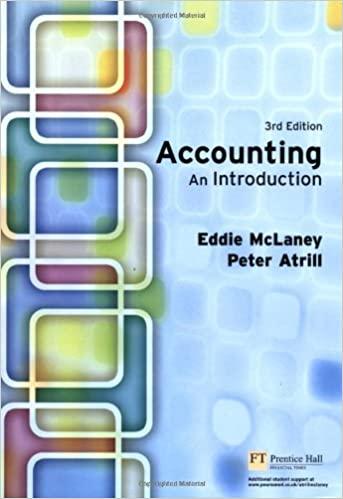Answered step by step
Verified Expert Solution
Question
1 Approved Answer
Companies that report significantly stronger earnings by using tailored figures like adjusted net income or adjusted operating incomeare more likely to encounter some kinds of
Companies that report significantly stronger earnings by using tailored figures like "adjusted net income" or "adjusted operating income"are more likely to encounter some kinds of accounting problems than those that stick to standard measures, according to research by consulting firm Audit Analytics.
Regulators and investors are increasingly wary when companies overemphasize their own customized earnings metrics. New research shows they may have a point.
Companies that report significantly stronger earnings by using tailored figures like "adjusted net income" or "adjusted operating income"are more likely to encounter some kinds of accounting problems than those that stick to standard measures, according to research by consulting firm Audit Analytics.
The rules allow companies to report such tailored figures, and the research, conducted for The Wall Street Journal, doesn't necessarily mean such companies are less scrupulous in their bookkeeping. But it does suggest that heavy use of metrics outside of generally accepted accounting principles sometimes referred to derisively as "earnings before bad stuff" could be a warning sign.
"I would say an overprominent user of nonGAAP metrics would justify more attention and is a red flag," said Olga Usvyatsky, Audit Analytics's vice president of research. Heavy use of nonGAAP metrics may indicate a company's accounting is "more aggressive," she said.
The study focused on companies in the S&P index. It found that just of those exclusively using standard GAAP metrics had formal earnings restatements from to Among heavy users of nonGAAP measures those whose nonGAAP earnings were at least twice as high as their GAAP net income the rate was
Similarly, of the GAAPonly group had material weaknesses in internal controls flaws in their procedures to prevent financial errors and fraud versus of the nonGAAP group.
Some of the numbers are small, and the use of nonGAAP metrics didn't specifically cause or relate directly to the companies' accounting flaws. Audit Analytics cautioned more research is needed.
Still, the results suggest companies using nonGAAP metrics heavily "may be somewhat less rigorous in other accounting areas" than companies using only GAAP, said Robert Pozen, a senior lecturer at the MIT Sloan School of Management.
Two examples are Valeant Pharmaceuticals International Inc. and LendingClub Corp. Both companies have been heavy users of pro forma metrics, and both have run into accounting and other problems that have hammered their shares.
Valeant restated earnings earlier this year over revenuebooking issues and said it had material weaknesses relating to its "tone at the top," or the commitment by a company's leadership to doing business ethically. Valeant has used nonGAAP metrics for years, often benefiting significantly. In the company had a GAAP loss of $ million but an "adjusted" nonGAAP profit of $ billion after stripping out amortization of intangible assets, acquisition costs and other expenses.
Valeant spokeswoman Laurie Little said the company believes its nonGAAP measures "are useful to investors in their assessment of our operating performance and the valuation of our company."
Online lender LendingClub forced its chief executive to resign in May after it found disclosure problems on some loans, and it too cited a "tone at the top" material weakness. The company had a GAAP loss of $ million but nonGAAP net income of $ million. LendingClub declined to comment.
Neither company was in the pool Audit Analytics examined.
Companies are allowed to use nonstandard metrics as long as they also provide GAAP numbers and show the differences between the two. The tailored measures strip out unusual or noncash items to present what companies say is a clearer picture of performance.
Even critics acknowledge the tailored metrics can sometimes be helpful showing a company's results in constant currency is a legitimate adjustment, for instance, Mr Pozen said.
But there is also a concern they are being abused, that companies are stripping out normal, ongoing costs to make themselves look healthier.
A study in June by financial dataresearch firm Calcbench and corporatecompliance consultant Radical Compliance showed nonGAAP metrics inflated earnings by $ billion over GAAP at a group of public companies.
In May, the Securities and Exchange Commission issued new guidelines warning companies against placing too much emphasis on nonGAAP metrics. The commission also has been taking issue with companies' nonGAAP disclosures more frequentlyin comment letters critiquing the companies' SEC filings.COMMENT ON THE ARTICLE ABOVE
Step by Step Solution
There are 3 Steps involved in it
Step: 1

Get Instant Access to Expert-Tailored Solutions
See step-by-step solutions with expert insights and AI powered tools for academic success
Step: 2

Step: 3

Ace Your Homework with AI
Get the answers you need in no time with our AI-driven, step-by-step assistance
Get Started


